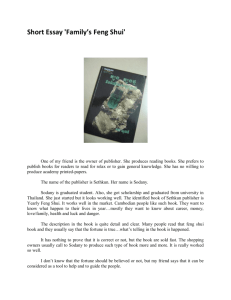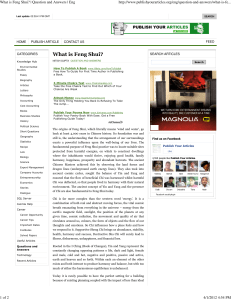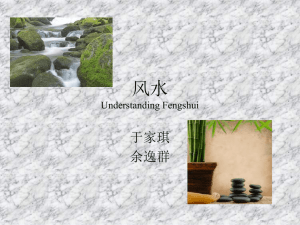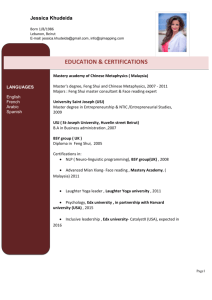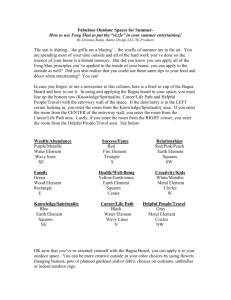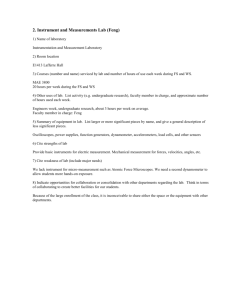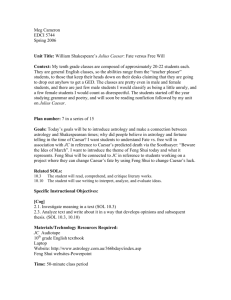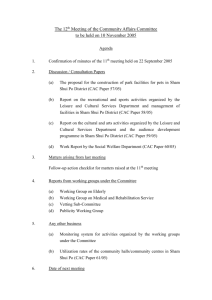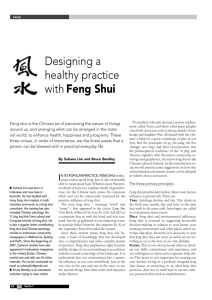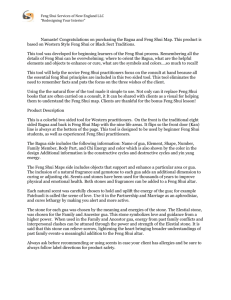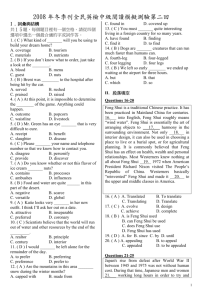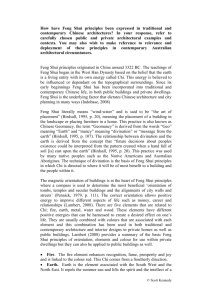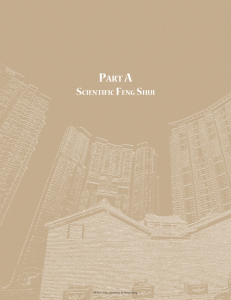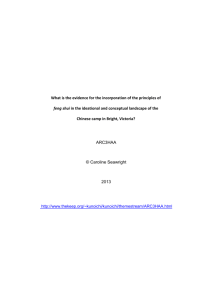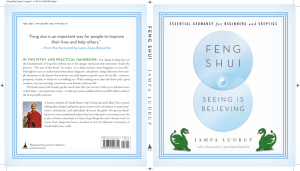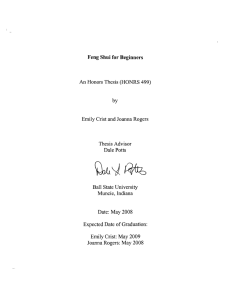Pluralism in Interior Design-sheet
advertisement
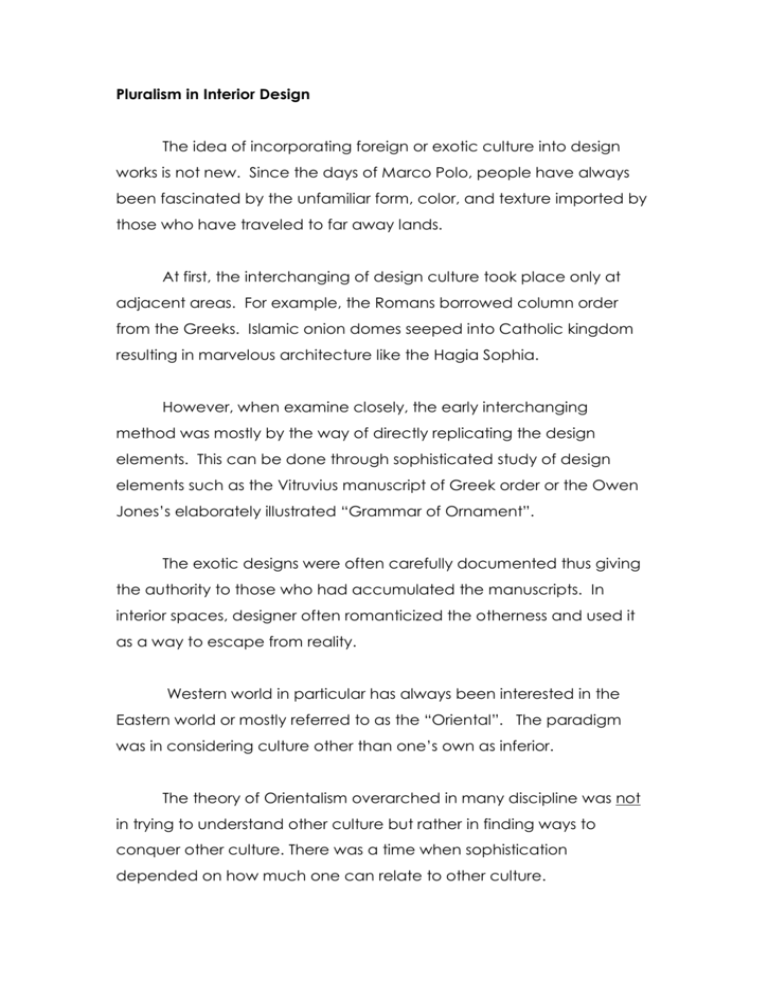
Pluralism in Interior Design The idea of incorporating foreign or exotic culture into design works is not new. Since the days of Marco Polo, people have always been fascinated by the unfamiliar form, color, and texture imported by those who have traveled to far away lands. At first, the interchanging of design culture took place only at adjacent areas. For example, the Romans borrowed column order from the Greeks. Islamic onion domes seeped into Catholic kingdom resulting in marvelous architecture like the Hagia Sophia. However, when examine closely, the early interchanging method was mostly by the way of directly replicating the design elements. This can be done through sophisticated study of design elements such as the Vitruvius manuscript of Greek order or the Owen Jones’s elaborately illustrated “Grammar of Ornament”. The exotic designs were often carefully documented thus giving the authority to those who had accumulated the manuscripts. In interior spaces, designer often romanticized the otherness and used it as a way to escape from reality. Western world in particular has always been interested in the Eastern world or mostly referred to as the “Oriental”. The paradigm was in considering culture other than one’s own as inferior. The theory of Orientalism overarched in many discipline was not in trying to understand other culture but rather in finding ways to conquer other culture. There was a time when sophistication depended on how much one can relate to other culture. However, as the history progressed, the world became smaller as people can connect to each other more easily. The two world wars had given the people valuable lessons and it was no longer appropriate to discriminate against culture other than one’s own. Since then, the paradigm of studying about other culture had shifted from mere documenting to understanding the underlying philosophy and other dimension of the culture. Other cultures are considered equally significant and should be treated with respect. Furthermore, the advent of paradigm shift in design discipline from Modernism to Post-Modernism fueled the idea of individualism and pluralism. Designers celebrated the diversity of cultures. The incorporation of other culture into design work can be done by various degrees. Some designers advocated a radical break from the Modern tradition. Some, however, in order to continue the Modern tradition soften the design with local sensibility. But the sharing goal is to demonstrate deeper understanding of the culture instead of merely incorporating known forms. Constructs of Orientalism Other cultures are superior or inferior to one’s own culture Culture is represented in direct application of known forms (from documentations) Derived Style Chinese influence in furniture Frank Lloyd Write Japanese influenced style Constructs of Pluralism Understanding of culture that have produced design Diversity is good design Design should be sensitive to local context All cultures are equally significant Derived style Ethnicism East –West Style Fusion Style Tropical Modern Excerpts from “ Home sweet (and tranquil) home by Dyer Lucinda Publishers Weekly; v. 247 no41 (Oct. 9 2000) p. 43-54 INFLUENCES FROM EASTERN PHILOSOPHIES For several years now, the ancient practice of feng shui has played an important role in interior design. While Williams at Barnes & Noble reports that sales of feng shui titles "seem to be leveling off," Sterling's Nurnberg is still a passionate supporter. "We are doing feng shui and we will continue to do feng shui. I definitely think it's here to stay--it's no longer just a trend, it has all the earmarks of becoming a category." Coming next month, Nurnberg reports, is Feng Shui Chic, in which Sharon Stasney offers stylish designs for harmonious living. Feng shui is also going strong at Rainy Day Books. "There are growing number of feng shui practitioners in Kansas City," Jennings says, "and the books are doing very well for us." Simon Brown, a feng shui consultant whose clients include British Airways and The Body Shop, launches Thorsons's new First Directions series with Feng Shui (Jan. 2001), an accessible, pocket-size introduction that explains the basic tenets. Stephen Skinner serves up ideas for everything from kitchen accessories to bed linens, children's rooms and garden pathways in Feng Shui for Modern Living, due in April from Trafalgar Square. Speaking of children's rooms, parents might want to give their kids' good chi a boost with Nancilee Wydra's Feng Shui for Children's Spaces: A Parent's Guide to Designing Environments in Which Children Will Thrive (Contemporary, Nov.). Feng shui, say its practitioners, is not limited to the home. Gill Hale's Feng Shui for a Successful Office is, says Anness sales director Vicki Warthen, "the perfect response to the dehumanizing cubicle environment of the Dilbert world." After discovering that her home office was located in a "relationship corner," Warthen immediately added something red (a photo of her significant other in a red frame) and reports that matters have taken a decided turn for the better. Vastu, the ancient Hindu science of design and architecture, has been popular in the U.S. for only the last year or so. One of the earliest trade books on the subject was Vastu Living: Creating a Home for the Soul by Kathleen Cox, which was released in August by Marlowe and Co. Last month, Destiny Books published Vaastu. The Indian Art of Placement-Design and Decorate Homes to Reflect Eternal Spiritual Principles by Rohit Arya. Juliet Pegrum, whose The Feng Shui Handbook sold some 123,000 copies, hopes for similar success with The Vastu Vidya Handbook: The Indian Feng Shui (Three Rivers Press, Dec.) DESIGNS FROM DISTANT LANDS International style books, says Williams at B&N, "are perennial backlist titles for us." But it's no longer just French country or English cottage, she adds, that are drawing customers into bookstores. "Fusion decorating, combining Eastern and Western design, is coming on strong"--a report that seems to bode well for Watson-Guptill's Fusion Interiors by Martin Waller and Dominic Bradbury. Billed as a virtual travel book for the home, this October release blends ideas from many different cultures into unique interiors. Tuttle's commitment to all things Asian began more than 50 years ago when founder Charles Tuttle translated Japanese books into English for the American market. Today, says sales director and acting president Steve Fischer, "every shelter magazine seems to have a piece about an exotic Balinese hideaway or a so-called Zen retreat. Americans aren't going to start living in tatami rooms (where would you keep the remote?), but there's a growing market for people who want to combine East and West." Three forthcoming titles from Tuttle's Periplus Editions should help satisfy this audience. Japan Modern by Michiko Rico Nose focuses on reinterpreting the traditional in contemporary Japanese design; Alexandra Black and Noboru Murata's The Japanese House: Architecture and Interiors is a photographic tour of 15 homes ranging from the very old to the ultramodern; and Contemporary Eastern by Alice Whately features sumptuously photographed interiors whose designs meld East and West-fromJohn Malkovich's L.A. bedroom to Betsey Johnson's New York City apartment. Other publishers, too, are realizing the popularity of Eastern style influences. Kodansha's The Japanese Dream House (Apr. 2001) by Azby Brown looks at how technology and tradition are shaping home design in Japan and focuses on the use of recycled materials in making the modern home. Vivienne Tam's just-published China Chic, says ReganBooks marketing director Carl Raymond, "is full of lush imagery, fabrics, interiors, ceramics--all of which have contributed to her sense of design and style." Flammarion has traveled the world for great design, as seen in three titles released earlier this year. Franck Ferrand offers a lavish look into the exclusive world of French design in Jacques Garcia: Decorating in the French Style; Gilles de Bure demonstrates how Asian objects and furnishings can be integrated into Western homes in Asian Style; and Stephane Guibourge shows how to create a sophisticated modern look in homes using the bold sculptural forms, rich earth colors and sensual textures of African Style. Designer Sharne Algotsson's first book, The Spirit of African Design, published in 1996 by Clarkson Potter, created a new market--AfricanAmericans looking for a personal style that reflected their heritage and experience. It also, reports editorial director Lauren Shakely, "received more press coverage than any design book we have ever done." In this month's African Style: Down to the Details, Algotsson uses photos, helpful tips and simple how-to projects to transform visions of an African interior into reality. This month Trafalgar Square launches its Global Designs for New Look Interiors Series with Marion Elliot's Tibet and Japan. In March, she'll follow up with Africa and Mexico. The series, says managing director Feldstein, grew out of a commitment to continue to do "something unique and different with our design books--hands-on projects inspired by foreign lands." Perhaps the ultimate wish book for lovers of the tropics, Tim StreetPorter's Tropical Houses: Living in Nature in Jamaica, Sri Lanka, Java, Bali, and the Coasts of Mexico and Belize (Clarkson Potter, Nov.) takes readers to some of the most beautiful paradises on earth. Along similar lines is Tuttle's Tropical Living (Mar. 2001), as Elizabeth Reyes visits contemporary dream houses in the Philippines. And while you're dreaming, check out the publisher's Bali Modern: The Art of Tropical Living by Gianni Francione. (Who knew there was an art to it?) In The Illustrated Cottage (Hearst), Country Living editor-at-large Niña Williams shows how she decorated her family's cottage as a life-size storybook, complete with characters and landscapes from the tiny Provencal village of Sault, circa 1918. Published in August, the book has already hit regional bestseller lists, says publisher Jacqueline Deval, and is "streaking out of the stores. We're going back to press to be fully stocked for Christmas."
